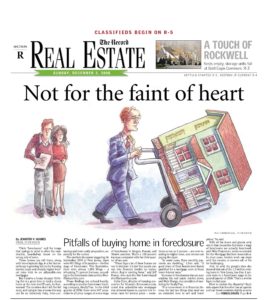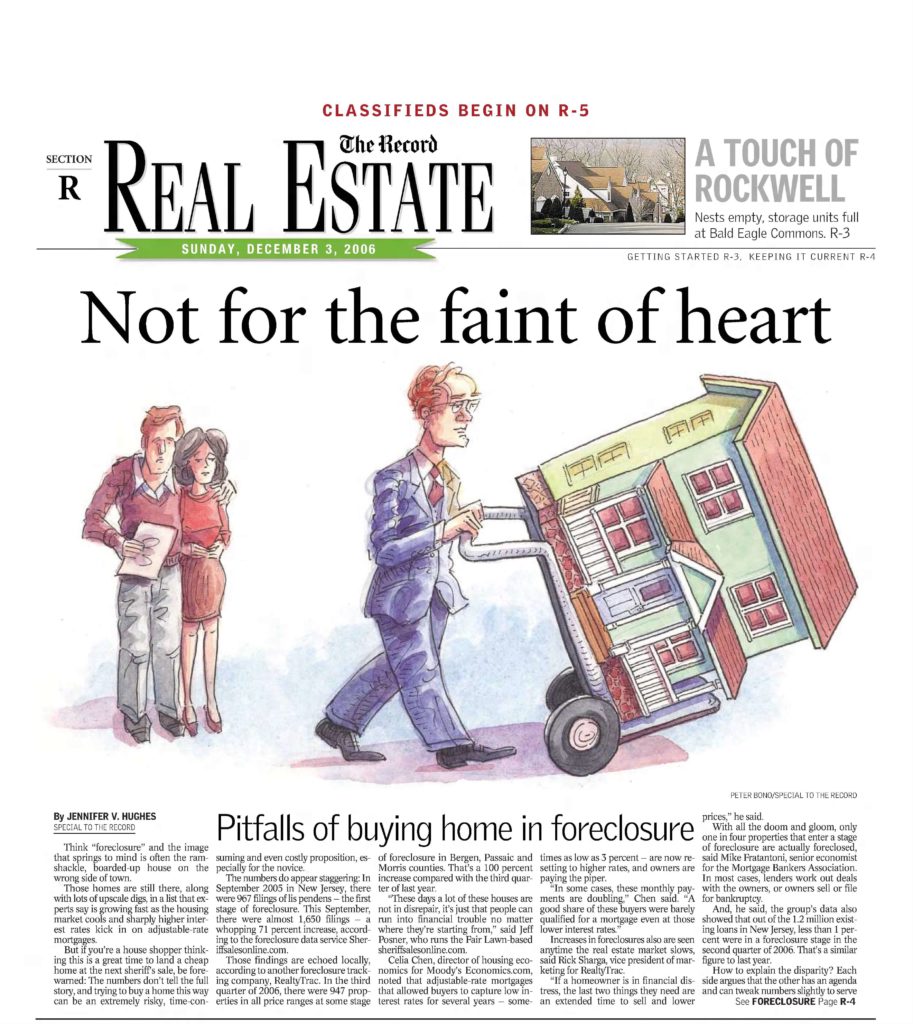New Jersey Home Foreclosure Indicator Rises 44% from Year Ago Quarter, Says Leading New Jersey Foreclosure Database
(2006) Lis pendens filings, a major home foreclosure indicator, jump substantially from from year-ago quarter. Upcoming mortgage rate “resets” could make the New Jersey foreclosure situation much worse.
Fair Lawn, NJ (PRWEB) November 14, 2006 — New Jersey’s leading home foreclosure database warned today that a key indicator of housing market instability in the state has jumped substantially from 2005 to 2006 – indicating that the state’s stalled-out housing market may have a rocky road ahead to recovery.
According to statistics compiled by the state’s leading online foreclosure data service, SheriffSalesOnline.com, the number of lis pendens filed in the state of New Jersey has risen 44% — from 2,486 in the third quarter of 2005 to 3,577 in the third quarter of 2006.
Fairlawn-based Sheriff Sales Online LLC provides advance notice of troubled properties to subscribers for a fee of $40 per month.
“Lis pendens are the first legal step taken in the home foreclosure process that indicate a homeowner is behind in his or her payments and headed for foreclosure,” says Jeffrey Posner, president of Sheriff Sales Online LLC, which provides comprehensive and timely advance notice of such troubled properties in the Lis Pendens, Public Notice and Sheriff List stages to its subscribers. “They are a recorded legal document filed with local courts that give notice to the public that an action affecting a particular piece of property has been filed. They are in the nature of a ‘quasi lien.’”
“A house in a lis pendens proceeding means it is about eight or nine months away from being sold in a sheriff’s sale,” says Posner.
In the Northeast, according to the National Association of Realtors, home prices in the second quarter of 2006 were down 16.3 percent from last year. In New Jersey specifically, second-quarter prices were down 11.6 percent.
The drop in prices may be a temporary opportunity for bargain hunting home-buyers – whether through the foreclosure process or through their local Realtor — to get a good deal, says Posner. Prices are expected to begin to rise again in the first quarter of 2007, but at a modest rate of about 1.6 percent. “But with the supply of available homes at its highest level since April 1993, now is a good time to buy a home, especially for bargain hunting first-time buyers,” he says.
According to a Nov. 10th report released by David Lereah, chief economist for the National Association of Realtors, sales of existing homes are expected to be roughly unchanged next year, while sales of new homes have further to fall before the market stabilizes.
According to that group’s highly-anticipated “2007 Outlook,” released on Friday at the Realtors’ annual convention in New Orleans, existing-home sales will probably fall 0.6% to 6.43 million next year after sinking 8.6% this year. New-home sales will probably fall 8.7% next year to 975,000 after plunging about 17% this year. Housing starts will probably fall about 12% next year to 1.63 million next year after falling 11% this year, he said. Sales prices are expected to rise only modestly.
The Realtors group anticipates a steady decline in inventories, and predicts that in early spring 2007, the market could shift from a buyers’ market to more of a balanced market. “In terms of market timing, that means that Fall of 2006 may be the ideal time for a real estate investor to take the plunge in order to benefit from next spring’s anticipated market change,” says Posner.
And the forecast of a 9 percent drop in home sales this year pales in comparison to other recent housing downturns. Existing-home sales plummeted 48 percent in the downturn of the early 1980s and dropped 18 percent in the milder recession of the early 1990s
Fueling the foreclosure boom is the fact that more than $200 billion worth of adjustable rate mortgages will “reset” at higher rates in 2006 and over $1 trillion will reset in 2007, says Posner.
“This situation, with monthly payments for many of these homes zooming to an unaffordable level, may edge more homeowners into the foreclosure process both in New Jersey and nationwide,” says Posner. More borrowers are finding it harder to meet interest payments following 17 interest-rate increases by the Federal Reserve since mid-2004. And about 18 percent of all mortgages issued in the first half of the year were to borrowers considered most likely to default, such as those with high credit-card balances, up from 2.4 percent in 1998, based on data from the Mortgage Bankers Association.
Nationwide, the percentage of home-loan payments nationwide that are more than 60 days delinquent rose to 7.23 percent in July from 5.9 percent a year earlier, the fastest rate of increase since 1998, according to Moody’s Investors Service. Meanwhile, with approximately 3.92 million homes currently for sale nationwide, the National Association of Realtors says the current inventory is at a 13-year high.
“That’s the first time in 15 years that home prices will have fallen,” says Posner. Sales of new and existing homes probably will drop 9.4 percent to 6.76 million in 2006 from a record last year, according to Freddie Mac.
A recent Wall Street Journal report notes that mortgage lenders are making it easier to get loans despite the cooling real estate market. That, along with more favorable mortgage interest rates averaging 6.4 percent will allow potential homeowners to spend less money purchasing a home than they would have last year.
Nationwide, according to one report, foreclosure activity in September 2006 showed an estimated 103,000 properties entering some stage of the foreclosure process during the 30-day period. Five states — Florida, California, Michigan, Texas and Colorado — accounted for an estimated 66 percent of September’s foreclosure filing action. New Jersey ranked No. 16th in the number of foreclosures per household, according to one study.
September figures, along with figures from July and August, show one new property entering some stage of the foreclosure process for every 1,122 U.S. households, up 14 percent compared to the second quarter of 2006.
Notably, Florida and the western states have a high proportion of loans in which mortgage holders pay only interest, not equity on their properties, which can result in foreclosures when interest rates rise.





